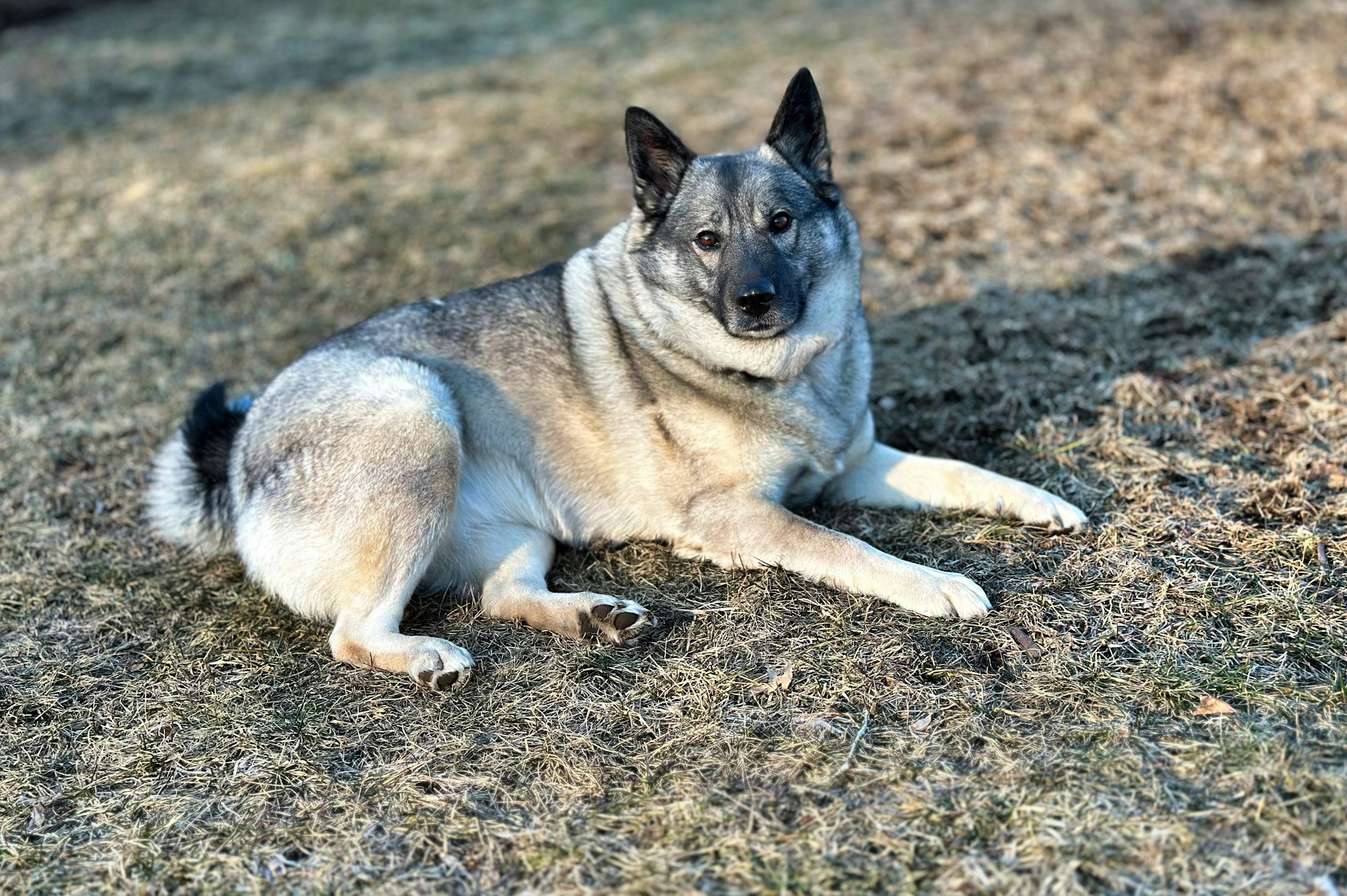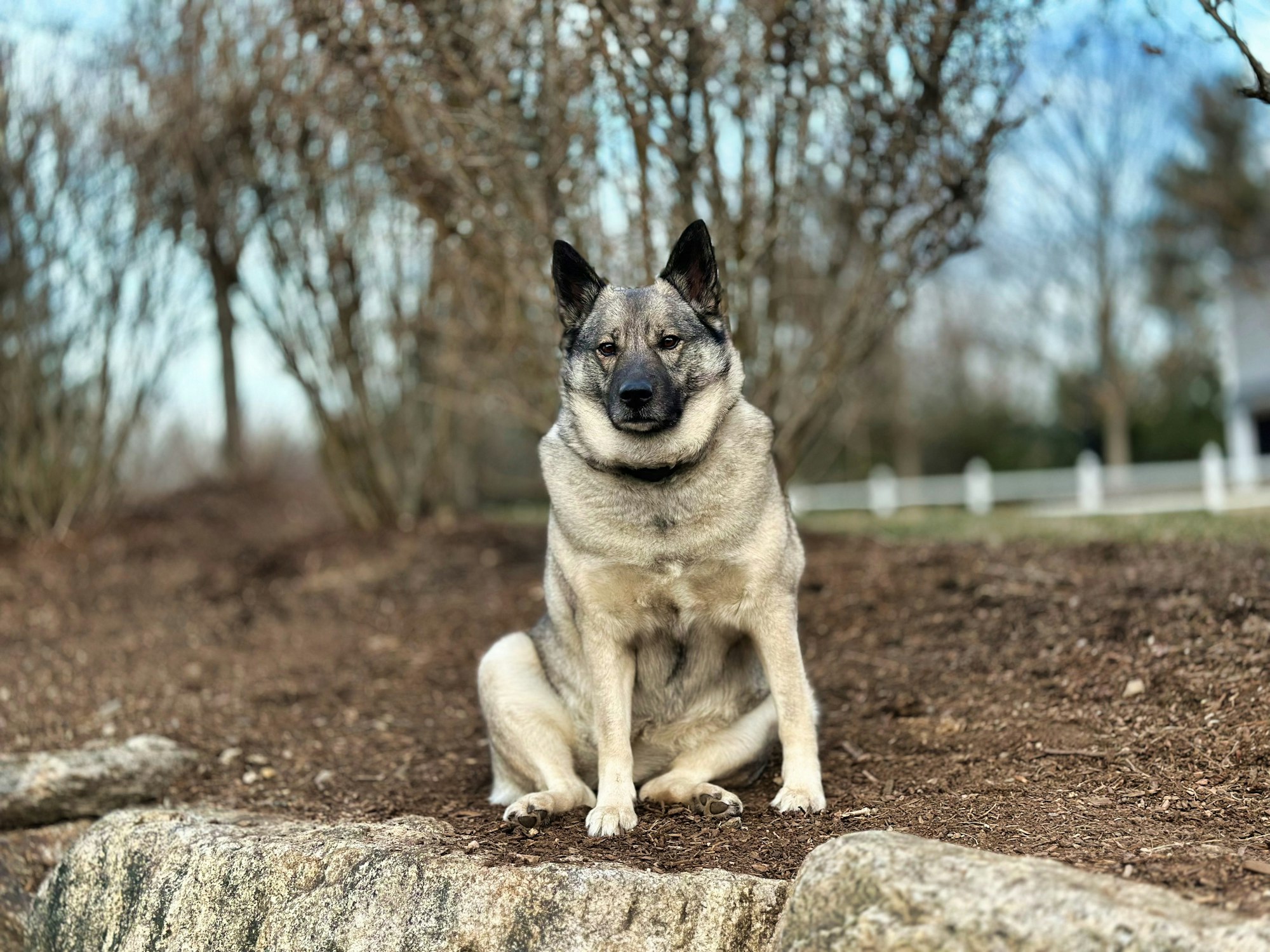Norwegian Elkhounds are an impressive and versatile breed of dog known for their strength, endurance, and unwavering loyalty. With their striking appearance and rich history, these dogs have captivated the hearts of many dog enthusiasts around the world. In this article, we will delve into the fascinating world of Norwegian Elkhounds, exploring their origins, physical characteristics, temperament, training requirements, and more.

The Norwegian Elkhound is a breed with ancient origins. They have been an integral part of Norwegian culture for centuries. These dogs were originally developed by the Vikings to hunt big game, including moose and bears. Their resilience, agility, and tracking skills made them invaluable hunting companions.
Physical Characteristics
Norwegian Elkhounds possess distinct physical characteristics that set them apart. Here are some notable features:
Size and Build
Norwegian Elkhounds are medium-sized dogs with sturdy build. They have a balanced and compact body structure. Adult males typically stand between 19.5 to 20.5 inches (49.5 to 52 cm) at the shoulder, while females are slightly smaller, ranging from 18 to 19.5 inches (45.5 to 49.5 cm). The weight of a fully-grown Norwegian Elkhound ranges from 48 to 55 pounds (22 to 25 kg).
Coat and Color
The breed's double coat is one of its most striking attributes. It consists of a dense, weather-resistant outer coat and a soft, woolly undercoat. The outer coat is straight, harsh, and of medium length. Norwegian Elkhounds come in various shades of gray, ranging from light silver to dark gray. Some may have black-tipped hairs, which give a distinct appearance.
Tail
The Norwegian Elkhound has a tightly curled tail that rests over its back. The tail is high-set and carried with pride. When the dog is relaxed, the tail may hang straight down. However, when the dog is alert or excited, the tail curls tightly and may rest against the dog's side.
Head and Facial Features
Norwegian Elkhounds have broad and wedge-shaped heads. The skull is slightly domed, and the muzzle is moderately long and strong. The breed's dark, oval-shaped eyes are expressive and convey intelligence. The ears are erect, pointing slightly forward, and have a slightly rounded shape at the tips.
Temperament and Personality
Norwegian Elkhounds are known for their distinctive temperament and unique personality traits. Here's what you can expect from these remarkable dogs:
Loyal and Protective
Norwegian Elkhounds are fiercely loyal to their families and make excellent guard dogs. They have a strong protective instinct and will not hesitate to defend their loved ones if they sense a threat. Their watchful nature and alertness make them reliable companions.
Friendly and Sociable
While Norwegian Elkhounds are known for their protective nature, they are also friendly and sociable dogs. They typically get along well with their family members, including children. Early socialization is crucial to ensure they are comfortable around strangers and other animals.
Intelligent and Independent
Norwegian Elkhounds are intelligent dogs that possess an independent streak. They are quick learners but may occasionally display stubbornness during training. Consistent and positive reinforcement methods work best when training these dogs. Mental stimulation is critical to keep them engaged and prevent boredom.
Active and Energetic
Being a hunting breed, Norwegian Elkhounds have a high energy level and require regular exercise. They enjoy outdoor activities such as brisk walks, jogging, and interactive play sessions. Providing them with sufficient physical exercise helps channel their energy and prevents behavioral issues.
Vocal and Expressive
Norwegian Elkhounds have a distinctive vocalization style and are known for their unique range of sounds. They tend to bark and howl, which can be an important aspect of their hunting heritage. It's essential to provide proper training and guidance to manage their vocalizations.
Training and Socialization
Training and socialization are crucial for Norwegian Elkhounds to become well-behaved and balanced dogs. Here are some important considerations:

Start Early
Begin training and socialization as early as possible, ideally during puppyhood. Early exposure to various people, animals, and environments helps Norwegian Elkhounds develop good manners and adaptability.
Positive Reinforcement
Use positive reinforcement techniques such as treats, praise, and rewards to motivate and encourage desired behaviors. Norwegian Elkhounds respond well to positive reinforcement and thrive in a training environment that is fun and engaging.
Consistency and Patience
Consistency is key when training a Norwegian Elkhound. Establish clear rules and boundaries and ensure everyone in the family follows them consistently. These dogs can be independent and may test boundaries, so patience and persistence are necessary.
Obedience and Basic Commands
Teach your Norwegian Elkhound basic obedience commands such as "sit," "stay," "come," and "down." Focus on building a strong foundation of obedience skills, which will help in managing their behavior and ensuring their safety.
Socialization with People and Animals
Expose your Norwegian Elkhound to a variety of people, including children and strangers, to help them develop good social skills. Introduce them to other friendly and well-behaved dogs in controlled environments to encourage positive interactions.
Remember, each dog is unique, and training requirements may vary. Tailor your training approach to suit your Norwegian Elkhound's individual needs and temperament. Stay tuned for the next sections covering exercise and activity needs, health and common issues, grooming and coat care, and more!
Exercise and Activity Needs
Norwegian Elkhounds are active and energetic dogs that require regular exercise to maintain their physical and mental well-being. Here are some crucial points to consider regarding their exercise and activity needs:

Daily Exercise
Norwegian Elkhounds should engage in daily exercise sessions to fulfill their activity requirements. Aim for at least 30 to 60 minutes of physical activity each day. This can include brisk walks, jogging, hiking, or playing in a securely fenced yard.
Mental Stimulation
In addition to physical exercise, Norwegian Elkhounds benefit from mental stimulation. Engage them in interactive games, puzzle toys, or training sessions that challenge their minds. This helps prevent boredom and provides a constructive outlet for their intelligence.
Outdoor Exploration
Norwegian Elkhounds have a strong sense of adventure and love to explore their surroundings. Consider taking them on hikes or providing opportunities for them to explore new environments. Ensure they are always leashed or in a secure area to prevent them from chasing after scents or wildlife.
Training and Activities
Incorporate training sessions and activities that tap into their natural instincts. Norwegian Elkhounds have a keen sense of smell, so scent work or tracking exercises can be highly enjoyable for them. They also excel in obedience, agility, and other canine sports.
Weather Considerations
Keep in mind that extreme weather conditions can affect your Norwegian Elkhounds exercise routine. During hot weather, schedule walks and activities during cooler times of the day to prevent overheating. In colder weather, ensure they are adequately protected with appropriate gear to keep them warm.
Remember to tailor the exercise routine to your Norwegian Elkhound's age, health, and individual energy levels. Regular exercise not only keeps them physically fit but also contributes to their overall happiness and well-being.
Health and Common Issues
Norwegian Elkhounds are generally a healthy breed. However, like all dogs, they may be prone to certain health issues. Understanding these common concerns can help you provide proper care for your Norwegian Elkhound:
Hip Dysplasia
Hip dysplasia is a common condition in which the hip joint doesn't develop properly. It can lead to lameness and arthritis. Regular exercise, a balanced diet, and maintaining a healthy weight can help minimize the risk of hip dysplasia. Responsible breeders often screen their breeding dogs for this condition.
Progressive Retinal Atrophy (PRA)
PRA is an inherited eye disease that causes gradual vision loss and, in severe cases, can lead to blindness. Regular eye examinations by a veterinarian and DNA testing of breeding dogs can help identify carriers and reduce the risk of passing on this condition.
Hypothyroidism
Hypothyroidism is a condition in which the thyroid gland doesn't produce enough hormones. It can lead to weight gain, lethargy, and skin issues. Regular veterinary check-ups and blood tests can help diagnose and manage hypothyroidism.
Other Considerations
Norwegian Elkhounds may also be susceptible to certain allergies, ear infections, and dental problems. Regular grooming, ear cleaning, and dental care are essential for their overall health and well-being. Providing a nutritious diet, regular exercise, and routine veterinary care are key to maintaining their optimal health.
Grooming and Coat Care
The Norwegian Elkhound's double coat requires regular grooming to keep it clean and healthy. Here are some grooming tips to keep in mind:
Brushing
Norwegian Elkhounds have a dense double coat that sheds moderately year-round and more heavily during shedding seasons. Regular brushing, at least two to three times a week, helps remove loose hair, prevent matting, and maintain the coat's condition.
Bathing
Bathe your Norwegian Elkhound as needed, typically every six to eight weeks or when they get dirty. Use a dog-specific shampoo and conditioner to keep their coat clean and moisturized. Be sure to dry them thoroughly after bathing to avoid skin issues.
Nail Care
Regular nail trims are needed to prevent overgrowth, discomfort, and potential injury. Trim your Norwegian Elkhound's nails every few weeks or as needed. If you're not comfortable doing it yourself, seek professional help from a groomer or veterinarian.
Dental Care
Maintaining good dental hygiene is crucial for your Norwegian Elkhound's overall health. Brush their teeth regularly with a dog-specific toothbrush and toothpaste. This helps prevent plaque buildup, gum disease, and other dental issues.
Ear Cleaning
Check and clean your Norwegian Elkhound's ears regularly to prevent wax buildup, infections, and discomfort. Use a dog-specific ear cleaner and follow the instructions provided. If you notice any signs of irritation or infection, consult your veterinarian.

Remember to provide positive reinforcement and make grooming sessions a positive experience for your Norwegian Elkhound. This helps them associate grooming with pleasant interactions and strengthens the bond between you. Stay tuned for the final sections covering feeding and nutrition, living arrangements, Norwegian Elkhounds as family pets, and working dogs.
Feeding and Nutrition
A well-balanced and nutritious diet is crucial for the overall health and well-being of Norwegian Elkhounds. High-quality dog food, specifically formulated for medium-sized breeds, should be provided in appropriate portions to maintain their weight and prevent obesity. Consulting with a veterinarian will help determine the right feeding schedule and dietary requirements for your specific dog.
Norwegian Elkhounds as Family Pets
With their affectionate and loyal nature, Norwegian Elkhounds make excellent family Norwegian Elkhounds make wonderful family pets and can be a great addition to your household. Here are some key points to consider:
Loyal Companions
Norwegian Elkhounds are known for their loyalty and devotion to their families. They form strong bonds with their owners and enjoy being involved in family activities. Whether it's going for walks, playing in the yard, or simply relaxing at home, Norwegian Elkhounds thrive on companionship and love being a part of the family.
Good with Children
Norwegian Elkhounds generally get along well with children. They are patient, gentle, and protective, making them suitable companions for kids. However, as with any dog, it's important to supervise interactions between children and dogs to ensure both parties are safe and comfortable.
Interaction with Other Pets
With proper socialization, Norwegian Elkhounds can coexist peacefully with other pets in the household. Early introductions and positive experiences with other animals help promote good relationships. However, their strong prey drive may make them prone to chasing smaller pets, so careful supervision is necessary.
Moderate Exercise Needs
Norwegian Elkhounds have moderate exercise requirements, making them suitable for various lifestyles. They enjoy daily walks, playtime, and mental stimulation. While they appreciate the physical activity, they can also adapt to living in apartments or homes with smaller yards as long as they receive regular exercise and mental enrichment.
Family Guardians
As natural protectors, Norwegian Elkhounds have a strong instinct to guard their families. They are alert, watchful, and quick to raise an alarm if they sense a potential threat. Their protective nature can provide a sense of security for your family and property.
When considering a Norwegian Elkhound as a family pet, it's required to provide them with proper training, socialization, and a loving, structured environment. With the right care and attention, they can be loyal, affectionate companions for many years.
Norwegian Elkhounds as Working Dogs
In addition to being great family pets, Norwegian Elkhounds have a rich history as working dogs. Here's a glimpse into their working capabilities:
Hunting Heritage
Norwegian Elkhounds were originally bred for hunting games, particularly large games like elk and bear. They have a keen sense of smell, excellent tracking abilities, and remarkable endurance. Norwegian Elkhounds would work alongside hunters, tracking and cornering game until the hunter arrived.

Versatility in Tasks
Apart from hunting, Norwegian Elkhounds have showcased their versatility in various tasks over the years. They have been utilized in search and rescue operations, tracking missing persons, and working with law enforcement agencies. Their intelligence, determination, and sense of smell make them well-suited for these roles.
Scent Work and Nose Sports
Due to their exceptional sense of smell, Norwegian Elkhounds excel in scent work and nose sports. They participate in activities such as tracking, scent detection, and search and rescue simulations. Engaging in these activities allows them to utilize their natural abilities and provides mental stimulation.
Working Drive and Trainability
Norwegian Elkhounds possess a strong working drive and are generally trainable. They are intelligent good family dogs that thrive on mental challenges and enjoy learning new tasks. Positive reinforcement methods, consistent training, and regular mental stimulation help bring out their best working abilities.
While Norwegian Elkhounds can excel as working dogs, it's important to note that their working instincts and energy levels require appropriate outlets. Engaging them in activities that tap into their natural abilities and providing them with a job or task can contribute to their overall well-being.
Norwegian Elkhounds can make exceptional family pets and working partners, thanks to their loyal nature, versatility, and working heritage.
Conclusion
In conclusion, Norwegian Elkhounds are remarkable dogs that offer loyalty, intelligence, and versatility to their owners. Whether as beloved family pets or dedicated working companions, they excel in various roles. However, owning a Norwegian Elkhound requires commitment, proper training, and an active lifestyle to ensure their well-being and happiness. If you're looking for a dog breed that embodies strength, resilience, and unwavering loyalty, the Norwegian Elkhound may be the perfect choice for you.
Frequently Asked Questions (FAQs)
1. Are Norwegian Elkhounds good with children?
· Yes, Norwegian Elkhounds are generally good with children. However, supervision and proper socialization are essential for a harmonious relationship.
2. How much exercise do Norwegian Elkhounds need?
· Norwegian Elkhounds are active dogs that require daily exercise. They should have a minimum of 1-2 hours of physical activity.
3. Do Norwegian Elkhounds shed a lot?
· Yes, Norwegian Elkhounds are moderate shedders. Regular brushing helps manage their shedding and keeps their coat healthy.
4. Are Norwegian Elkhounds suitable for apartment living?
· While Norwegian Elkhounds can adapt to apartment living, they thrive in environments with access to a securely fenced yard for exercise and exploration.
5. Do Norwegian Elkhounds get along with other pets?
· With proper socialization, Norwegian Elkhounds can get along well with other pets. Early introductions and training are key for successful interactions.




